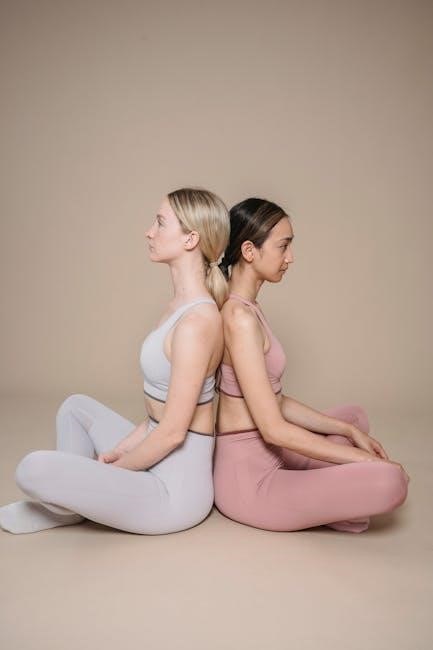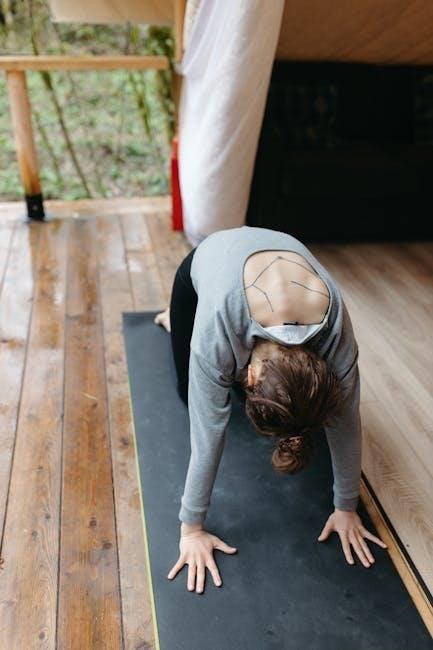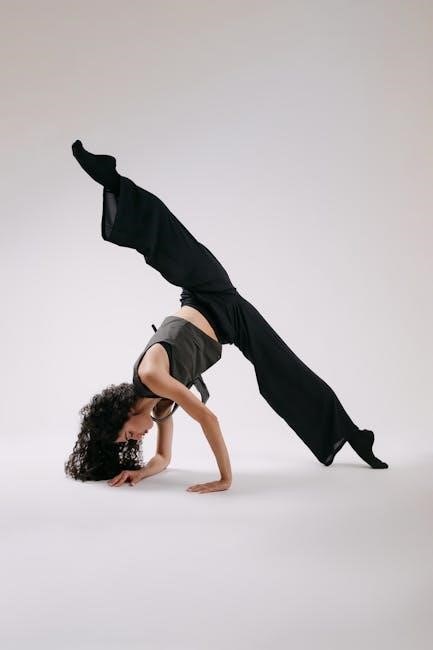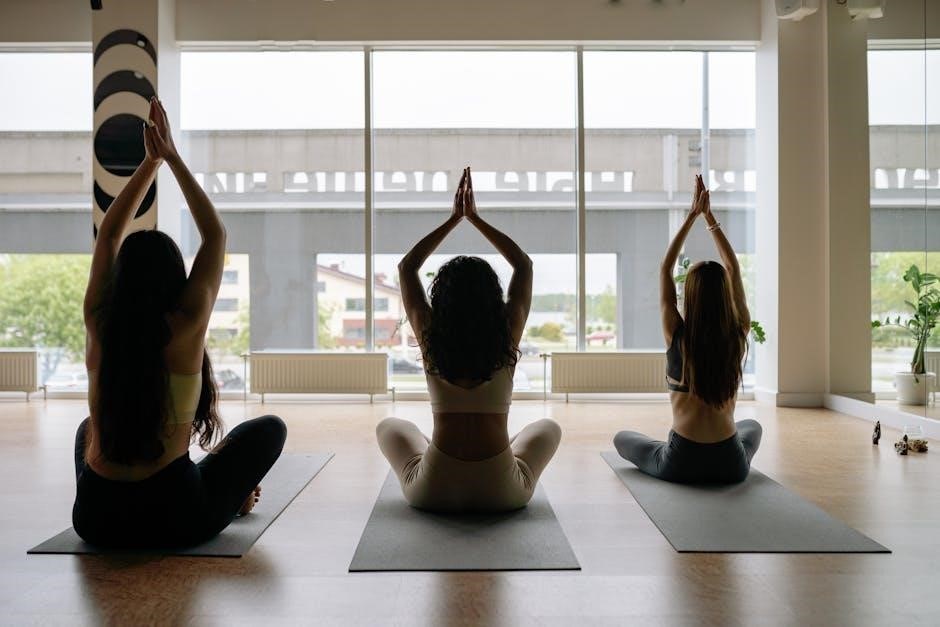Bikram Yoga is a 90-minute practice featuring 26 poses in a heated room, systematically targeting every body part. The Bikram Yoga Poses PDF is a detailed guide, perfect for mastering each asana with step-by-step instructions and visual cues, ideal for both beginners and advanced practitioners to enhance their practice effectively.
What is Bikram Yoga?
Bikram Yoga, also known as Hot Yoga, is a structured 90-minute practice consisting of 26 specific poses and two breathing exercises performed in a heated room (105°F/40°C). Developed by Bikram Choudhury, this method systematically works every part of the body, targeting muscles, ligaments, and tendons. The sequence is designed to promote oxygenated blood flow, detoxification, and overall physical and mental well-being. The Bikram Yoga Poses PDF serves as a comprehensive guide, detailing each asana’s benefits, proper alignment, and modifications, making it an invaluable resource for both beginners and experienced practitioners aiming to deepen their practice and achieve optimal results.
History and Development of Bikram Yoga
Bikram Yoga, developed by Bikram Choudhury in the 1970s, is rooted in traditional Hatha Yoga techniques. Choudhury, a student of Bishnu Ghosh in India, created a 26-pose sequence designed to be practiced in a heated environment (105°F/40°C) to simulate the Indian climate. The method gained popularity in the West for its structured, repetitive approach, ensuring consistency across classes. The Bikram Yoga Poses PDF reflects this lineage, providing detailed insights into the historical context and evolution of the practice. It serves as a bridge between the traditional roots and modern adaptations, helping practitioners understand the foundational principles and benefits behind each asana.

Structure of the Bikram Yoga Sequence
The Bikram Yoga sequence is a 90-minute class featuring 26 specific poses and two breathing exercises, designed to systematically target every part of the body in a heated environment. The structured sequence ensures consistent practice, with each pose held for a specific duration to maximize benefits. The Bikram Yoga Poses PDF provides a detailed breakdown of the sequence, enhancing understanding and execution for practitioners at all levels.
Overview of the 90-Minute Class
A Bikram Yoga class is a structured 90-minute session conducted in a heated room at 105°F (40°C). It begins with Standing Deep Breathing to warm up the body and prepare for the sequence. The class follows a fixed order of 26 poses and two breathing exercises, each held for a specific duration to maximize benefits. The poses are designed to target every part of the body, improving strength, flexibility, and circulation. The session concludes with Savasana (Corpse Pose) for deep relaxation. The Bikram Yoga Poses PDF provides a detailed guide to the sequence, offering step-by-step instructions and visual cues to enhance practice and ensure proper alignment.
Breakdown of Standing, Balancing, Floor, and Final Relaxation Poses
The Bikram Yoga sequence includes standing, balancing, floor, and final relaxation poses. Standing poses like Mountain Pose and Eagle Pose improve alignment and breathing. Balancing postures, such as Tree Pose and Toe Stand, enhance focus and stability. Floor postures, including Cobra Pose and Rabbit Pose, target the spine and internal organs. The final relaxation pose, Savasana, allows the body to recharge. The Bikram Yoga Poses PDF provides detailed instructions for each category, ensuring proper alignment and maximum benefits. This structured approach helps practitioners progress safely and effectively, making the practice accessible to all levels while promoting overall well-being.

Standing Postures in Bikram Yoga
Standing postures in Bikram Yoga, such as Mountain Pose and Eagle Pose, are foundational, improving alignment, balance, and focus. They initiate the sequence, preparing the body for deeper stretches and strengthening muscles, while promoting proper breathing techniques essential for the practice.
Mountain Pose (Tadasana) and Its Significance
Mountain Pose, or Tadasana, is the foundational standing posture in Bikram Yoga, setting the basis for proper alignment and breathing. It engages the entire body, promoting balance, posture, and energy flow. Practiced at the beginning of the sequence, it prepares the body for subsequent poses by establishing a strong, grounded stance. The Bikram Yoga Poses PDF highlights its importance, providing step-by-step instructions to ensure proper form, such as engaging the core, lifting the chest, and rooting the feet firmly on the ground. This pose improves overall physical awareness and serves as a mental focal point, helping practitioners maintain concentration throughout the class.
Eagle Pose (Garudasana) and Its Benefits
Eagle Pose, or Garudasana, is a standing balancing posture in Bikram Yoga that enhances focus, balance, and strength. It stretches the shoulders, hips, and upper back while improving circulation and joint mobility. The pose involves crossing the legs and arms, requiring concentration to maintain stability. The Bikram Yoga Poses PDF provides detailed instructions, emphasizing proper alignment and breathing techniques. Regular practice of Eagle Pose strengthens the calves and ankles, improving overall balance and posture. It also helps in reducing stress and mental tension, fostering a sense of calm and clarity. This pose is particularly beneficial for improving coordination and mental focus, making it a key component of the Bikram sequence.

Balancing Postures in Bikram Yoga
Balancing postures in Bikram Yoga, like Tree Pose and Toe Stand, improve stability, focus, and mental clarity. The Bikram Yoga Poses PDF offers detailed instructions and tips for mastering these postures, enhancing overall balance and coordination while strengthening the legs and ankles. Regular practice helps build concentration and reduces stress, fostering a stronger mind-body connection. These poses are essential for improving physical and mental equilibrium, making them a cornerstone of the Bikram sequence.
Tree Pose (Vrksasana) and Its Importance
Tree Pose (Vrksasana) is a foundational balancing posture in Bikram Yoga, strengthening the legs and improving focus. It enhances stability, concentration, and mental clarity. The Bikram Yoga Poses PDF provides detailed alignment cues and modifications, helping practitioners master this pose regardless of skill level. By standing on one leg, Tree Pose builds confidence, balance, and physical equilibrium. It also strengthens the ankles and calves, improving overall posture. The mental discipline required for this pose fosters calmness and reduces stress. Regular practice of Vrksasana promotes better coordination and body awareness, making it a vital component of the Bikram Yoga sequence for both physical and mental growth.
Toe Stand (Padangusthasana) and Its Benefits
Toe Stand (Padangusthasana) is a balancing posture that strengthens the feet, ankles, and calves while improving balance and coordination. It enhances focus and concentration by requiring mental stability. The Bikram Yoga Poses PDF provides detailed instructions for proper alignment, emphasizing the importance of engaging the core and maintaining a straight spine. This pose helps prevent injuries by building sturdy ankles and improving overall foot health. Regular practice of Padangusthasana boosts confidence and physical equilibrium, making it an essential part of the Bikram Yoga sequence for both beginners and advanced practitioners to master balance and stability effectively.

Floor Postures in Bikram Yoga
Floor postures in Bikram Yoga strengthen the spine, hips, and abdominal muscles. The Bikram Yoga Poses PDF details these postures, enhancing practice with visual cues and alignment tips for optimal benefits.
Cobra Pose (Bhujangasana) and Its Role
Cobra Pose, or Bhujangasana, is a foundational floor posture in Bikram Yoga that strengthens the back muscles and improves spinal flexibility. It is performed by lying on the stomach and lifting the chest and head off the ground. This pose targets the thoracic spine, enhancing posture and reducing back pain. The Bikram Yoga Poses PDF provides detailed step-by-step instructions, emphasizing proper alignment and breathing techniques. Modifications are included for beginners to ensure safe practice. Bhujangasana is essential for building core strength and preparing the body for more advanced postures; Regular practice improves spinal mobility and overall upper body strength, making it a cornerstone of the Bikram sequence.
Other Key Floor Postures and Their Functions
Beyond Cobra Pose, the Bikram Yoga sequence includes other essential floor postures that target specific muscle groups and improve overall flexibility. Poses like Rabbit Pose (Sasangasana) and Leg Stretch Pose (Paschimottanasana) stretch the spine and hamstrings, while strengthening the core. These postures are designed to enhance circulation, relieve tension, and promote detoxification. The Bikram Yoga Poses PDF provides clear instructions and modifications for these asanas, ensuring safe and effective practice. Each floor posture plays a vital role in the sequence, contributing to a balanced and comprehensive workout. Regular practice of these postures can improve posture, reduce lower back pain, and boost overall physical and mental well-being.
Final Relaxation Pose
The final relaxation pose, Savasana, is essential for rejuvenation. The Bikram Yoga Poses PDF guides proper alignment and breathing, enhancing the meditative experience and promoting deep relaxation.
Savasana (Corpse Pose) and Its Purpose
Savasana, or Corpse Pose, is the final relaxation pose in Bikram Yoga, designed to rejuvenate the body and mind. The Bikram Yoga Poses PDF provides detailed instructions on how to achieve the perfect Savasana, emphasizing proper alignment and breathing techniques. This pose allows the body to absorb the benefits of the previous postures, promoting deep relaxation and mental clarity. The guide ensures practitioners can fully surrender, letting go of tension and stress. By mastering Savasana, one can enhance the overall meditative experience, making it a crucial ending to the 90-minute sequence. It’s a moment to reflect and rejuvenate, essential for both physical and mental well-being.
Benefits of Deep Relaxation in Bikram Yoga
Deep relaxation in Bikram Yoga, particularly through Savasana, offers profound mental and emotional benefits. It helps reduce stress, anxiety, and tension, promoting a sense of calm and clarity. The Bikram Yoga Poses PDF highlights how this final relaxation pose allows the body to recharge, enhancing overall well-being. By completely surrendering and letting go, practitioners experience improved focus, reduced fatigue, and a stronger connection between mind and body. This practice fosters resilience, emotional balance, and a renewed sense of energy, making deep relaxation an essential component of the Bikram Yoga experience. The guide ensures practitioners can maximize these benefits, leading to a more mindful and rejuvenated state.

Benefits of Bikram Yoga
Bikram Yoga offers numerous physical and mental benefits, including increased strength, flexibility, and cardiovascular health. It enhances mental clarity, reduces stress, and promotes detoxification through sweat. The Bikram Yoga Poses PDF provides a comprehensive guide to achieve these benefits effectively, ensuring a balanced and transformative practice for all levels.
Physical Benefits: Muscle Strength, Flexibility, and Cardiovascular Health
Bikram Yoga significantly enhances muscle strength by engaging all major muscle groups through its 26-pose sequence. The practice improves flexibility by stretching muscles, tendons, and ligaments in a heated environment, which warms the body for deeper stretches. Additionally, the cardiovascular system benefits as the heart rate increases, boosting circulation and endurance. The combination of standing, balancing, and floor postures works synergistically to strengthen the body while promoting overall physical fitness. Regular practice can lead to improved posture, toned muscles, and enhanced physical endurance, making it a holistic workout for the body. The Bikram Yoga Poses PDF provides detailed guidance to maximize these physical benefits safely and effectively.
Mental and Emotional Benefits: Stress Reduction and Focus
Bikram Yoga offers profound mental and emotional benefits, particularly in reducing stress and enhancing focus. The practice’s structured sequence and heated environment help calm the mind, promoting mental clarity and resilience. By focusing on precise postures and breathing techniques, practitioners develop concentration and discipline, which translates into improved focus in daily life. The physical challenges of the practice foster emotional resilience, empowering individuals to manage stress more effectively. The Bikram Yoga Poses PDF provides guidance on proper alignment and breathing, ensuring a meditative experience that balances the mind and body. Regular practice can lead to a sense of calm, reduced anxiety, and improved overall mental well-being, making it a holistic approach to emotional health.

Modifications for Beginners
The Bikram Yoga Poses PDF offers step-by-step adjustments for newcomers, ensuring safe practice. It provides modifications to gradually build strength and flexibility, catering to all fitness levels.
Adjustments for Safe Practice
The Bikram Yoga Poses PDF provides essential adjustments for a safe and effective practice. It includes step-by-step instructions for modifying poses to suit individual needs, ensuring proper alignment and preventing injuries. The guide offers visual cues and detailed explanations, helping beginners understand how to adapt poses for their flexibility and strength levels. By following these adjustments, practitioners can gradually build endurance and confidence. The PDF emphasizes the importance of listening to one’s body and honoring its limitations, making it an invaluable resource for those new to Bikram Yoga; These modifications ensure a sustainable and injury-free practice, fostering progress at a comfortable pace.
Building Strength and Flexibility Gradually
The Bikram Yoga Poses PDF guides practitioners in progressively building strength and flexibility through consistent practice. Each pose is designed to target specific muscles and ligaments, ensuring a balanced development of the body. The PDF offers variations for each asana, allowing individuals to challenge themselves as they advance. By following the structured sequence, students can enhance their range of motion and overall physical endurance. The guide emphasizes the importance of patience and gradual improvement, making it suitable for all fitness levels. Regular practice, coupled with proper alignment, helps in achieving long-term strength and flexibility, transforming the body and mind holistically over time.
Importance of the Bikram Yoga Poses PDF
The Bikram Yoga Poses PDF is a comprehensive guide, offering detailed instructions and visual cues for mastering the 26 asanas. It enhances practice by providing clear alignment tips, modifications, and physiological insights, ensuring a safe and effective journey for all levels of practitioners.
What the Guide Includes
The Bikram Yoga Poses PDF is a detailed guide that includes step-by-step instructions for each of the 26 asanas, along with visual cues and modifications for different fitness levels. It provides Sanskrit names, purposes, and benefits of each pose, helping practitioners understand their physiological effects. The guide also offers physiological explanations, ensuring a comprehensive understanding of each posture’s impact on the body. Designed for both beginners and experienced practitioners, it serves as a valuable resource for mastering the sequence effectively and safely.
How the PDF Enhances Your Practice
The Bikram Yoga Poses PDF enhances your practice by providing clear, step-by-step instructions and visual cues, helping you master each asana with precision. It offers modifications for different fitness levels, ensuring a safe and effective practice tailored to your needs. The guide’s detailed breakdown of each pose’s benefits and physiological effects deepens your understanding, allowing you to maximize the workout’s impact. Whether you’re a beginner or an experienced practitioner, this comprehensive resource helps you stay focused and aligned, enhancing both physical and mental benefits of the practice. It’s an essential tool for improving technique and achieving consistent progress in your Bikram Yoga journey.

Using the Bikram Yoga Poses PDF
The PDF serves as a comprehensive guide, offering step-by-step instructions and visual cues for each pose, making it easy to follow and understand for all practitioners.
Step-by-Step Instructions and Visual Cues
The Bikram Yoga Poses PDF provides detailed step-by-step instructions for each of the 26 asanas, ensuring proper alignment and execution. Visual cues, such as diagrams and images, accompany each pose, offering a clear understanding of the correct form. These resources are particularly beneficial for beginners, guiding them through complex postures with ease. The instructions are concise, focusing on key actions like breathing techniques, muscle engagement, and movement transitions. By following these guides, practitioners can maximize the benefits of each pose while minimizing the risk of injury, enhancing their overall Bikram Yoga experience.
Modifications and Variations for Different Fitness Levels
The Bikram Yoga Poses PDF offers modifications and variations to suit various fitness levels, ensuring accessibility for everyone. Beginners can start with gentler adjustments, gradually increasing intensity as they build strength and flexibility. Advanced practitioners can explore deeper expressions of each pose, enhancing their practice. The guide provides alternatives for individuals with physical limitations, allowing them to engage safely and effectively. These modifications promote inclusivity, making Bikram Yoga a versatile practice for all, regardless of experience or ability. By catering to different needs, the PDF supports a personalized and progressive approach to mastering the 26 poses. This adaptability ensures continuous growth and engagement for every practitioner.
Breathing Exercises in Bikram Yoga
Bikram Yoga incorporates breathing exercises like Standing Deep Breathing (Pranayama) to enhance oxygen flow and mental clarity. These techniques, detailed in the PDF, aid stress reduction and focus, complementing the physical postures for a holistic practice.
Standing Deep Breathing (Pranayama)
Standing Deep Breathing, or Pranayama, is the foundational breathing exercise in Bikram Yoga. Performed at the beginning of each class, it involves standing in Mountain Pose (Tadasana) and deeply inhaling and exhaling through the nose. This practice is designed to prepare the body for the subsequent poses by increasing oxygen flow and focus. The PDF guide provides detailed instructions on proper breathing techniques, emphasizing the importance of synchronizing breath with movement. Regular practice of Standing Deep Breathing helps improve respiratory capacity, reduce stress, and enhance mental clarity, setting a meditative tone for the entire 90-minute session.
Other Breathing Techniques and Their Benefits
Beyond Standing Deep Breathing, Bikram Yoga incorporates other breathing techniques to enhance practice. The PDF guide details these methods, such as Kapalabhati and Bhramari, which are not part of the standard sequence but are often recommended for advanced practitioners. These techniques aid in detoxification, improved respiratory function, and mental focus. The guide emphasizes proper alignment and execution, ensuring safe and effective practice. By mastering these breathing exercises, students can deepen their overall yoga experience, balance their nervous system, and achieve a higher state of relaxation and mental clarity, complementing the physical benefits of the 26 Bikram poses.

Comparison with Other Yoga Forms
Bikram Yoga differs from Hatha and Vinyasa Flow through its structured 26-pose sequence in a heated room, offering a unique blend of intensity and therapeutic benefits.
Bikram Yoga vs. Hatha Yoga
Bikram Yoga and Hatha Yoga differ significantly in structure and approach. Bikram Yoga follows a fixed 26-pose sequence in a heated room, emphasizing systematic stretching and detoxification. Hatha Yoga, a more traditional practice, focuses on classic postures and breathing techniques without heat. While Bikram Yoga is intense and uniform, Hatha Yoga offers flexibility in pose selection and pacing. The Bikram Yoga Poses PDF provides a detailed guide to its structured sequence, making it easier for practitioners to follow the specific order and modifications. In contrast, Hatha Yoga often varies by instructor, allowing for a more personalized experience. Both practices aim to balance body and mind but cater to different preferences and goals.
Bikram Yoga vs. Vinyasa Flow
Bikram Yoga and Vinyasa Flow are distinct in their approaches to practice. Bikram Yoga involves a fixed sequence of 26 poses performed in a heated room, emphasizing consistency and detoxification. Vinyasa Flow, often called “flow yoga,” focuses on synchronizing breath with dynamic movements, offering a varied and flowing sequence of postures. Unlike Bikram’s rigid structure, Vinyasa Flow is more flexible, catering to individual needs and creative expression. The Bikram Yoga Poses PDF provides a structured guide, while Vinyasa Flow relies on spontaneous movement. Both practices enhance physical and mental well-being but differ in style, environment, and philosophical focus.

Practitioner Testimonials
Practitioners rave about Bikram Yoga’s transformative effects, sharing stories of improved health, mental clarity, and emotional well-being. Many credit the practice for life-changing physical and spiritual growth.
Real-Life Experiences with Bikram Yoga
Practitioners share inspiring stories of how Bikram Yoga transformed their lives. Many report improved physical health, weight loss, and enhanced mental clarity. The structured 26-pose sequence, guided by the PDF, helps practitioners master each asana, building confidence and strength. Emotional benefits, such as reduced stress and increased focus, are frequently cited. Some describe the practice as challenging yet rewarding, fostering a sense of accomplishment. The heated environment and systematic approach create a unique experience that many find addictive. These real-life experiences highlight Bikram Yoga’s profound impact on both body and mind, encouraging others to embrace this transformative practice.
Success Stories and Transformations
Practitioners worldwide share remarkable success stories, attributing Bikram Yoga to significant life changes. Many have achieved weight loss, improved flexibility, and enhanced overall health. The 26-pose sequence, detailed in the PDF, has helped individuals overcome chronic pain and injuries. Mental transformations are equally profound, with many reporting reduced anxiety and improved focus. The practice fosters a sense of discipline and self-awareness, leading to personal growth. These success stories highlight the transformative power of Bikram Yoga, inspiring others to explore its benefits. The PDF guide serves as a valuable tool, enabling practitioners to follow the sequence accurately and achieve their wellness goals effectively.
Bikram Yoga offers transformative physical and mental benefits, with the PDF guide serving as an essential resource for mastering the 26 poses and enhancing your practice effectively.
Summing Up the Key Points
Bikram Yoga is a structured 90-minute practice featuring 26 poses performed in a heated environment, designed to systematically work every part of the body. The Bikram Yoga Poses PDF serves as an invaluable resource, offering detailed instructions, visual cues, and modifications for all fitness levels. It emphasizes proper alignment and breathing techniques, ensuring a safe and effective practice. The guide highlights the benefits of each pose, from improving flexibility and strength to enhancing cardiovascular health and mental focus. By following the PDF, practitioners can deepen their understanding of the sequence and maximize the transformative potential of Bikram Yoga, whether they are beginners or experienced enthusiasts.
Encouragement to Try Bikram Yoga
Embarking on a Bikram Yoga journey offers transformative physical and mental rewards. The structured 26-pose sequence, combined with the unique heated environment, provides a holistic workout that strengthens, stretches, and detoxifies the body. Whether you’re a beginner or an experienced practitioner, the Bikram Yoga Poses PDF serves as an excellent companion, guiding you through each asana with clarity. Embrace the challenge, and you’ll discover improved flexibility, enhanced cardiovascular health, and a calmer mind. The sense of accomplishment and renewed energy after each class is unparalleled. Take the first step today, and let Bikram Yoga empower you to achieve your wellness goals and embrace a healthier lifestyle.
